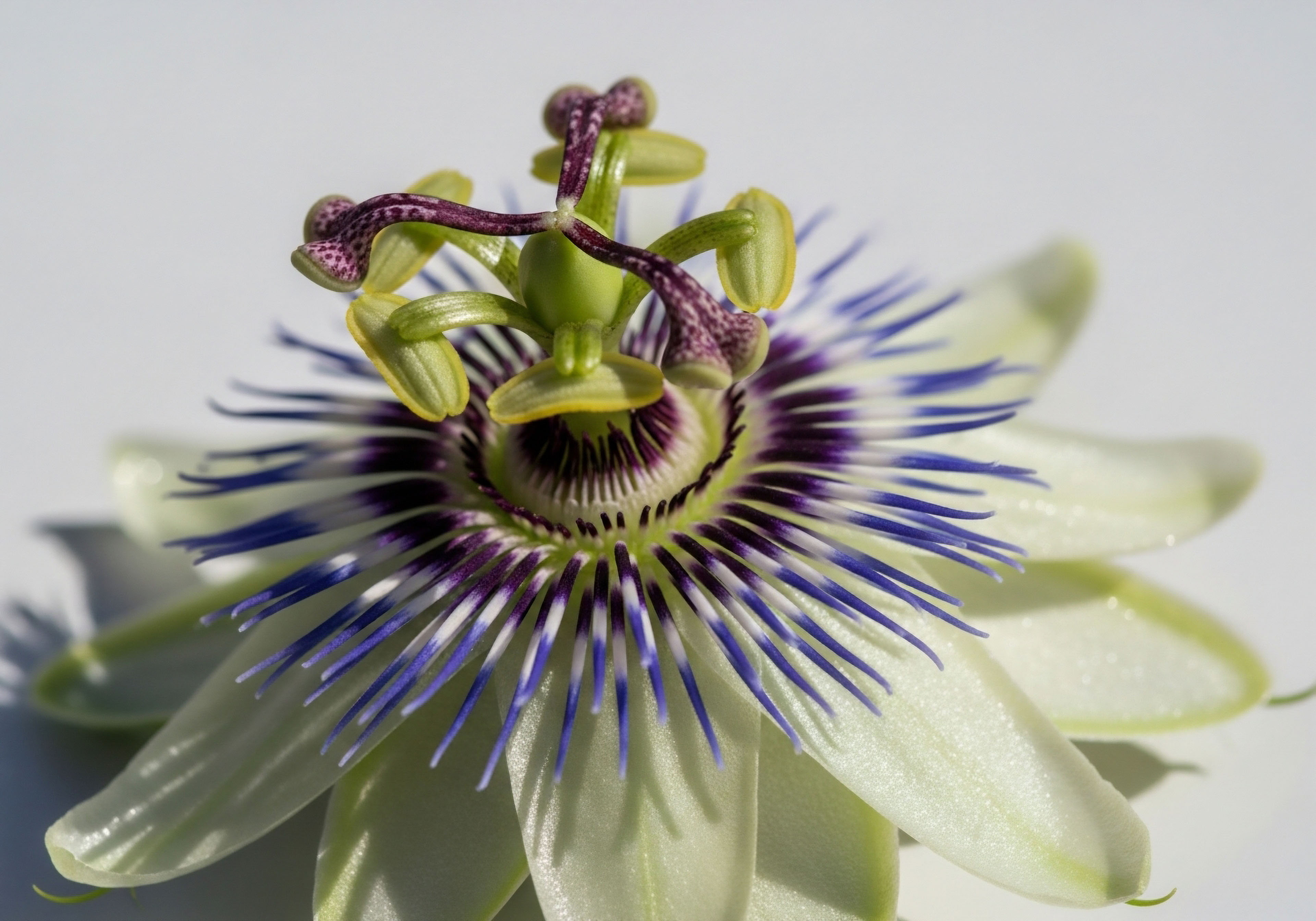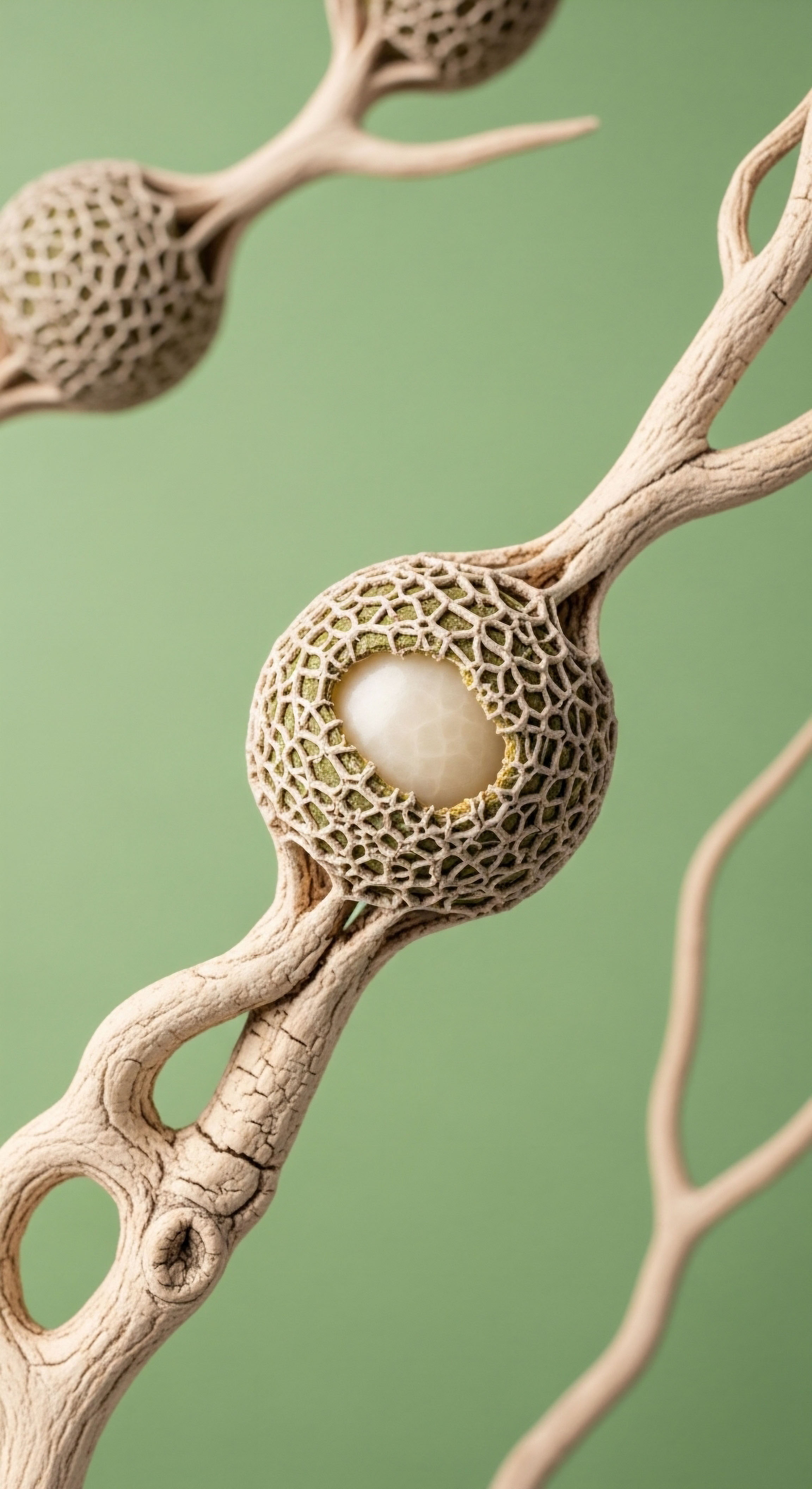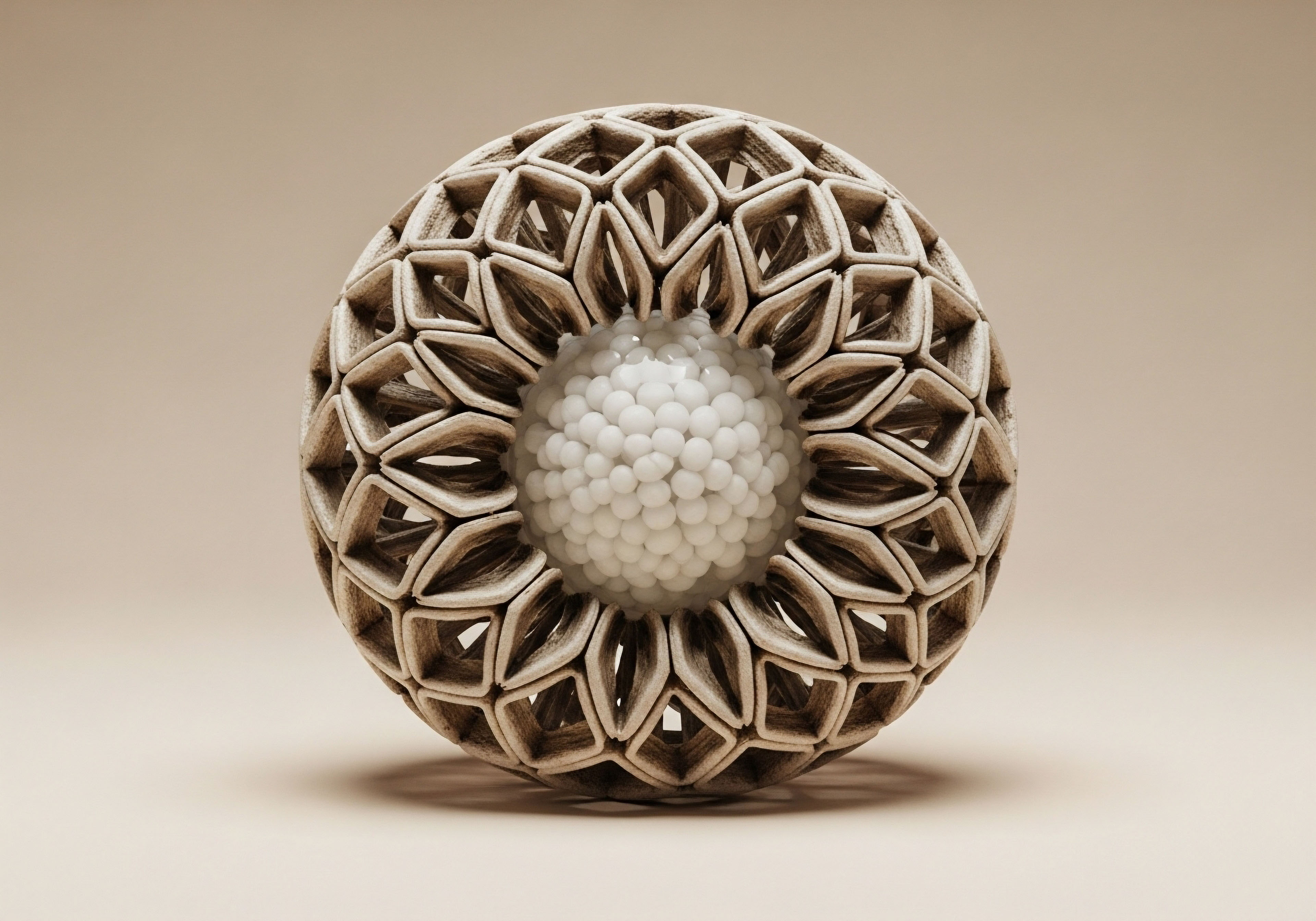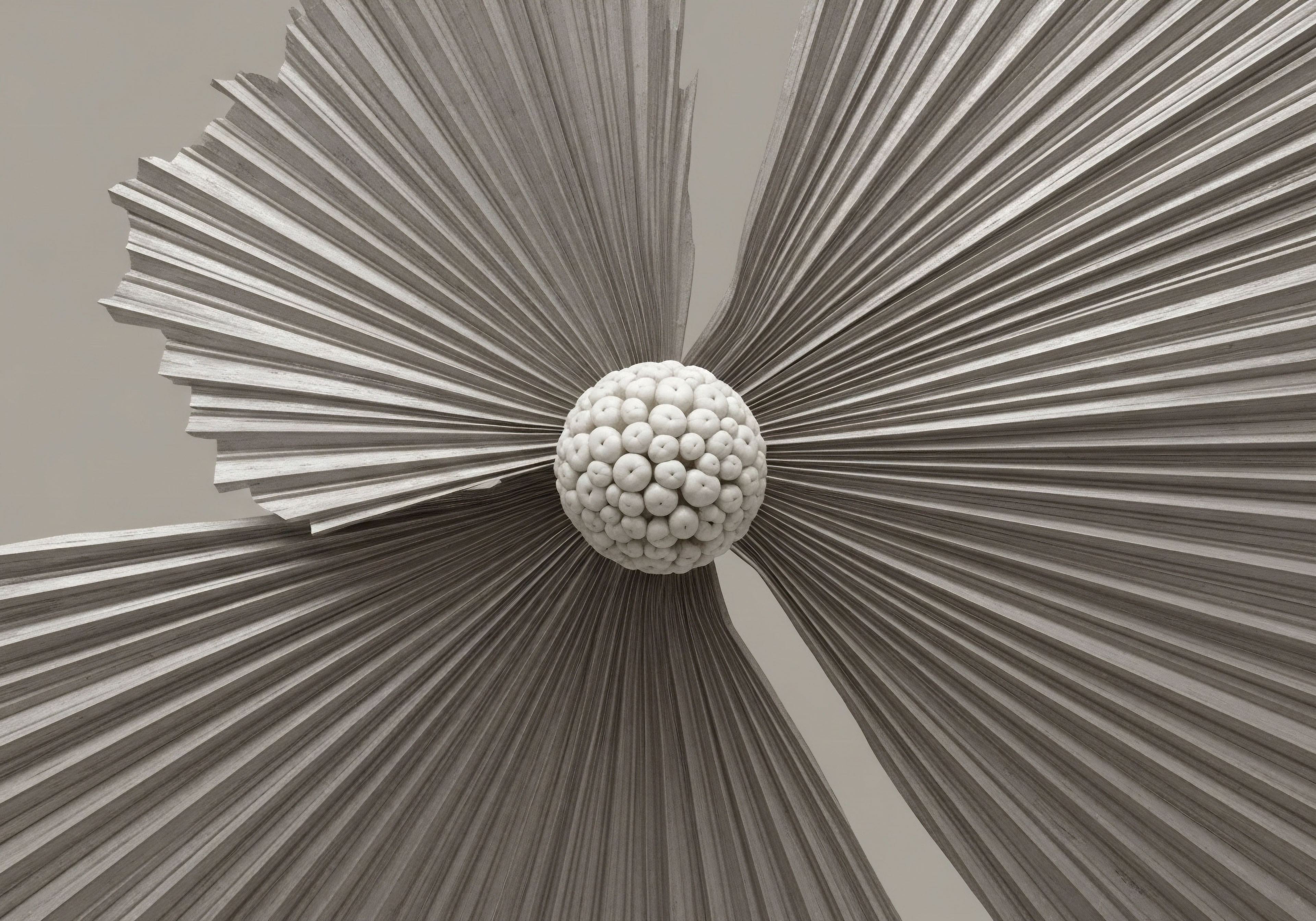

Fundamentals
You may feel a subtle, persistent sense of disharmony within your body. It could manifest as a lack of energy that sleep does not resolve, a shift in your mood that feels untethered to your daily life, or a change in your physical vitality that seems premature.
This experience is valid, and it often points toward the intricate communication network that governs your physiology. Your body operates on a system of messages and responses, a biological conversation that, when flowing correctly, supports your function and well-being. At the very heart of hormonal health is one of the most important of these conversations, orchestrated by the Hypothalamic-Pituitary-Gonadal (HPG) axis.
This axis is the central command structure for your reproductive and endocrine systems. Think of it as a precise, three-part relay. It begins in the hypothalamus, a small, ancient region of your brain responsible for maintaining the body’s internal balance.
The hypothalamus initiates the hormonal cascade by releasing a specific molecule ∞ Gonadotropin-Releasing Hormone, or GnRH. Gonadorelin is the manufactured, bioidentical form of this natural hormone. It is the starting signal, the first word in a sentence that directs the production of your sex hormones.
When the hypothalamus releases GnRH, it travels a very short distance to the pituitary gland. The pituitary, acting as the master regulator, receives this signal and responds by producing two other hormones ∞ Luteinizing Hormone (LH) and Follicle-Stimulating Hormone (FSH). These gonadotropins then travel through the bloodstream to the gonads ∞ the testes in men and the ovaries in women.
Upon their arrival, LH and FSH deliver their instructions. In men, LH stimulates the Leydig cells in the testes to produce testosterone, while FSH is integral to sperm production. In women, these same hormones orchestrate the menstrual cycle, follicular growth, and ovulation. This entire sequence is a beautifully regulated feedback loop. The hormones produced by the gonads, like testosterone and estrogen, signal back to the brain, modulating the release of GnRH and maintaining a dynamic equilibrium.
Gonadorelin acts as the initial trigger in the body’s natural hormone production sequence, starting a cascade that involves the brain, pituitary gland, and gonads.
The question of using Gonadorelin independently to optimize this system is a profound one. It asks whether we can restore the entire symphony by simply prompting the conductor. In a system where the downstream instruments ∞ the pituitary and the gonads ∞ are healthy, responsive, and capable of playing their part, providing the initial signal can indeed restore the music.
This is the foundational principle of its use in specific medical contexts. If the issue is a lack of the initial signal from the hypothalamus, then supplying that signal with Gonadorelin can reactivate the entire axis, allowing the body to recalibrate its own hormonal environment.
This approach hinges on the health and readiness of the rest of the system. Its effectiveness is entirely dependent on a functional pituitary and responsive gonads. Therefore, using Gonadorelin as a standalone therapy is a strategy of restoration. It is a way to re-engage a healthy system that has fallen silent due to a problem at the very beginning of the signaling chain. The goal is to restart the body’s own elegant, self-regulating machinery for hormonal balance.


Intermediate
Understanding the foundational role of Gonadorelin as the body’s primary hormonal starting signal opens a more detailed examination of its clinical application. The therapeutic use of Gonadorelin is defined by its biological function and, most importantly, its very short half-life of two to ten minutes.
This fleeting presence in the bloodstream means that its administration must mimic the body’s own natural rhythm. The hypothalamus does not release GnRH in a steady stream; it releases it in pulses, approximately every 90 to 120 minutes. To be effective, therapeutic Gonadorelin must replicate this pulsatile pattern.

Pulsatile Therapy a Clinical Necessity
The primary clinical application for independent Gonadorelin therapy is in treating conditions where the HPG axis is intact but dormant due to a failure of the hypothalamus. A principal example is congenital hypogonadotropic hypogonadism (CHH), a rare condition where the brain does not produce enough GnRH from birth.
In these individuals, the pituitary and gonads are typically healthy but unstimulated. The established protocol for this involves a portable infusion pump that administers a small, subcutaneous dose of Gonadorelin every 90 minutes. This method successfully replicates the natural pulse of the hypothalamus, awakens the pituitary to produce LH and FSH, and initiates puberty or restores fertility.
This pulsatile requirement is what makes independent Gonadorelin use for general hormonal “optimization” in a broader population so impractical. A twice-weekly subcutaneous injection, a common protocol for other peptides, would be ineffective. The signal would be present for only a few minutes and then disappear for days, which is insufficient to sustain the continuous stimulation needed for balanced hormone production. The body’s hormonal system is a persistent, rhythmic conversation, and a momentary signal cannot sustain it.

Gonadorelin as an Adjunct to Testosterone Therapy
A more common and practical application of Gonadorelin is as an adjunctive therapy for men undergoing Testosterone Replacement Therapy (TRT). When a man receives exogenous testosterone, his body’s feedback loop detects the high levels of the hormone. In response, the hypothalamus stops releasing GnRH.
This shutdown of the natural signal causes the pituitary to cease its production of LH and FSH. Without these stimulating hormones, the testes stop producing endogenous testosterone and sperm, which leads to testicular atrophy and potential infertility.
Here, Gonadorelin is used to keep the natural system active. By administering Gonadorelin two or three times a week, a man on TRT can send a periodic signal to his pituitary. This prompts the release of LH and FSH, which in turn stimulates the testes.
This protocol is designed to preserve testicular size and function during TRT. It keeps the internal machinery primed and operational, even while the primary testosterone supply is external. In this context, Gonadorelin is not optimizing the system independently; it is working in concert with TRT to maintain the health of the entire HPG axis.
The clinical utility of Gonadorelin is defined by its administration protocol, which must mimic the body’s natural pulsatile release to be effective.

Comparing Gonadorelin and HCG
In the context of adjunctive TRT support, it is helpful to compare Gonadorelin with another commonly used agent, human chorionic gonadotropin (hCG). While both are used to prevent testicular atrophy, they work at different points in the HPG axis.
| Feature | Gonadorelin (GnRH Analog) | Human Chorionic Gonadotropin (hCG) |
|---|---|---|
| Mechanism of Action |
Acts on the pituitary gland, stimulating it to produce the body’s own LH and FSH. |
Acts as an LH analog, directly stimulating the Leydig cells in the testes to produce testosterone and maintain volume. |
| Point of Intervention |
Upstream, at the level of the pituitary gland. It preserves the function of the entire HPG axis. |
Downstream, at the level of the gonads. It bypasses the brain and pituitary. |
| Effect on Natural Hormones |
Promotes the release of both LH and FSH, which can help maintain spermatogenesis alongside testosterone production. |
Primarily mimics LH. It is very effective for testosterone production but less so for stimulating FSH-dependent processes. |
| Administration Protocol |
Requires frequent, pulsatile administration for independent use, or typically 2-3 times per week as an adjunct to TRT. |
Has a longer half-life, allowing for less frequent injections, typically 2-3 times per week. |

What Are the Regulatory Considerations in China for Gonadorelin Use?
The regulatory landscape for hormonal therapies in any country is complex and specific. In China, the National Medical Products Administration (NMPA) governs the approval and use of all pharmaceutical agents. Gonadorelin, as a recognized medical treatment for specific endocrine disorders, is available through prescription within the formal healthcare system.
Its use is typically confined to hospital settings or specialized fertility clinics for its approved indications, such as CHH or for diagnostic purposes. The use of Gonadorelin for non-approved purposes, such as an adjunct to TRT for general wellness or anti-aging, would fall outside of these formal guidelines.
This places such use in a gray area, where it may be prescribed off-label by physicians in private clinics who specialize in hormonal health, but it would not be part of standard institutional protocols.


Academic
A sophisticated analysis of Gonadorelin’s independent therapeutic potential requires a deep investigation of the neuroendocrine architecture that governs the Hypothalamic-Pituitary-Gonadal (HPG) axis. The entire system is predicated on the activity of a specialized group of neurons in the hypothalamus known as the GnRH pulse generator.
These neurons are responsible for the episodic, rhythmic secretion of GnRH, a pattern that is absolutely fundamental for sustained gonadotropin secretion from the anterior pituitary. A continuous, non-pulsatile exposure to GnRH or its agonists leads to the downregulation and desensitization of GnRH receptors on the pituitary gonadotropes, ultimately causing a paradoxical suppression of the axis. This is the principle behind certain cancer therapies and demonstrates that the signal’s rhythm is as important as the signal itself.

The Neurobiology of the GnRH Pulse Generator
The GnRH pulse generator is not a single anatomical nucleus but a network of about 1,500-2,000 neurons that fire in synchronized bursts. The activity of this network is modulated by a complex interplay of neurotransmitters and neuropeptides. A key regulator of this system is Kisspeptin, a peptide produced by neurons in the arcuate nucleus (ARC) and the anteroventral periventricular nucleus (AVPV) of the hypothalamus.
Kisspeptin neurons synapse directly with GnRH neurons and are considered the primary drivers of GnRH release. They are the “gatekeepers” of the HPG axis, integrating various internal and external signals to control reproductive function.
The system is also regulated by powerful negative feedback mechanisms. Testosterone, and its aromatized byproduct estradiol, act on receptors in both the hypothalamus and the pituitary. They inhibit the release of Kisspeptin and GnRH at the hypothalamic level and reduce the sensitivity of the pituitary gonadotropes to GnRH.
This feedback is what maintains hormonal homeostasis. Other neuropeptides, such as neurokinin B and dynorphin, also play a part in the intricate choreography of the GnRH pulse, forming a complex system of accelerators and brakes that fine-tunes the rhythm of the axis.
The effectiveness of Gonadorelin is dictated by its ability to replicate the precise, pulsatile rhythm of the endogenous GnRH pulse generator, a complex neural network in the hypothalamus.
This intricate regulatory network illustrates why independent Gonadorelin therapy for general “optimization” is a biologically simplistic approach to a complex system. Administering exogenous Gonadorelin bypasses this entire layer of sophisticated, integrated regulation. It cannot adapt to the body’s changing needs, stress levels, or metabolic status. It is a static input into a dynamic system.
While pulsatile pump therapy can effectively replace a non-existent GnRH signal in cases of CHH, it is a replacement for a single missing component. It does not replicate the nuanced modulation of a healthy, functioning hypothalamic network.

Systemic Interconnectivity the HPG and HPA Axes
The HPG axis does not operate in isolation. It is deeply interconnected with other major physiological systems, most notably the Hypothalamic-Pituitary-Adrenal (HPA) axis, the body’s central stress response system. Chronic activation of the HPA axis, leading to elevated levels of cortisol, has a profound inhibitory effect on the HPG axis at multiple levels.
Cortisol can suppress the GnRH pulse generator in the hypothalamus, reduce pituitary sensitivity to GnRH, and impair gonadal function directly. This is a teleological mechanism designed to suppress reproduction during times of high stress or famine, conserving metabolic resources for survival.
This interaction has significant implications for any hormonal optimization strategy. A person with chronically elevated stress levels may have a suppressed HPG axis that is unresponsive to simple Gonadorelin stimulation. The root cause of the hormonal imbalance in this case is not a primary failure of the HPG axis itself, but a secondary suppression from an overactive HPA axis.
A successful clinical intervention would require addressing the HPA axis dysregulation. This highlights the necessity of a systems-biology perspective, where hormonal balance is viewed as an emergent property of multiple interacting systems.

Components of Endocrine Signaling Axes
To fully appreciate the complexity, it is useful to delineate the components of these interconnected systems.
| Axis Component | HPG Axis (Reproduction) | HPA Axis (Stress) |
|---|---|---|
| Hypothalamic Signal |
Gonadotropin-Releasing Hormone (GnRH) |
Corticotropin-Releasing Hormone (CRH) |
| Pituitary Response |
Luteinizing Hormone (LH) & Follicle-Stimulating Hormone (FSH) |
Adrenocorticotropic Hormone (ACTH) |
| End Organ |
Gonads (Testes/Ovaries) |
Adrenal Glands |
| Primary Output |
Testosterone, Estradiol, Progesterone |
Cortisol, Aldosterone |
| Primary Function |
Regulation of reproduction, metabolism, and secondary sexual characteristics. |
Regulation of the stress response, immune function, and energy metabolism. |
- Inter-Axis Communication ∞ High levels of cortisol from the HPA axis can actively suppress GnRH release, demonstrating a clear hierarchical relationship where survival (HPA) can override reproduction (HPG).
- Feedback Loops ∞ Both axes are governed by negative feedback, where the final hormone (e.g. testosterone or cortisol) inhibits the upstream signals in the hypothalamus and pituitary to maintain balance.
- Clinical Implications ∞ An individual presenting with symptoms of low testosterone might have a primary issue within the HPG axis, or their condition could be secondary to chronic stress activating the HPA axis. A therapeutic approach focused solely on Gonadorelin would fail if the latter were true.

How Does Commercialization Affect Gonadorelin Protocols in China?
The commercialization of healthcare in China, particularly in the private sector, creates a market for wellness and anti-aging services that may operate with different protocols than the state-run system. Private clinics catering to affluent clients interested in hormonal optimization may be more willing to prescribe medications like Gonadorelin off-label.
This can lead to a divergence in practice. While academic and public hospitals adhere strictly to evidence-based protocols requiring pulsatile pumps for independent use, some private clinics might offer simplified, less frequent injection schedules. These simplified protocols are driven by patient convenience and commercial viability.
They are less likely to be effective due to the short half-life of Gonadorelin, but they are easier to market and administer than a 24/7 infusion pump. This creates a potential gap between scientifically validated treatments and commercially offered protocols.

Could Off-Label Use of Gonadorelin in China Create Legal Risks for Practitioners?
Yes, the off-label prescription of any drug in China carries potential legal and professional risks for physicians. While the practice of off-label prescribing is common worldwide and often clinically necessary, it must be supported by a strong evidence base and sound medical judgment.
If a practitioner prescribes a simplified, ineffective Gonadorelin protocol that deviates significantly from established scientific principles (i.e. the need for pulsatile delivery), they could be vulnerable to legal challenges, particularly if a patient experiences adverse effects or a lack of results.
The risk is amplified in a commercial setting where financial incentives might be perceived as influencing clinical decisions. To mitigate this risk, practitioners must maintain meticulous documentation of their clinical reasoning, obtain informed consent that clearly outlines the off-label nature of the treatment and its potential limitations, and stay current with the latest clinical research. Prescribing Gonadorelin without acknowledging the fundamental requirement for pulsatile administration would be difficult to defend from a medical-legal standpoint.

References
- Tsutsui, K. & Ubuka, T. (2018). Emerging insights into hypothalamic-pituitary-gonadal axis regulation and interaction with stress signalling. Journal of Neuroendocrinology, 30(10), e12590.
- Liu, Z. et al. (2019). The Pulsatile Gonadorelin Pump Induces Earlier Spermatogenesis Than Cyclical Gonadotropin Therapy in Congenital Hypogonadotropic Hypogonadism Men. Andrology, 7(1), 85-91.
- NovaGenix. (2020). Does gonadorelin work?. Retrieved from NovaGenix’s website. (Note ∞ While this is a clinic’s article, it directly cites and explains the protocol from the Liu et al. study, making its explanation of the mechanism and half-life useful for translation).
- LIVV Natural. (n.d.). TRT and Fertility ∞ How to Maintain Fertility While on Testosterone Therapy. Retrieved from LIVV Natural’s website. (Note ∞ This source synthesizes clinical approaches and provides a clear comparison of HCG and Gonadorelin in the context of TRT).
- IAM Clinic. (n.d.). Maximizing Male Health ∞ TRT and Gonadorelin Synergy Explained. Retrieved from IAM Clinic’s website. (Note ∞ This provides a patient-facing explanation of the synergy between TRT and Gonadorelin for maintaining testicular function).
- Plant, T. M. (2015). 60 YEARS OF NEUROENDOCRINOLOGY ∞ The hypothalamo-pituitary ∞ gonadal axis. Journal of Endocrinology, 226(2), T41-T54.
- Tan, R. S. (n.d.). Gonadorelin for Men on Testosterone Replacement Therapy (TRT). Retrieved from a physician’s informational website. (Note ∞ Provides a clinical perspective on prescribing Gonadorelin adjunctively with TRT).
- DrugBank Online. (n.d.). Gonadorelin. Retrieved from DrugBank’s database. (Note ∞ Used to verify clinical trial phases and drug information).
- Quintana Granda, P. et al. (2005). The hypothalamic ∞ pituitary ∞ gonadal axis ∞ immune function and autoimmunity. Journal of Endocrinology, 184(2), 237-245.

Reflection

Recalibrating Your Internal Blueprint
The information presented here offers a map of a specific territory within your body’s vast biological landscape. It details the pathways, signals, and feedback loops that constitute your hormonal health. This knowledge provides a framework for understanding the origins of symptoms that can diminish your sense of vitality.
It transforms abstract feelings of being “off” into a concrete understanding of physiological processes. This map is a powerful tool. It allows you to move from a passive experience of your symptoms to an active, informed position in your own health narrative.
Your personal health journey is unique. The balance of your internal systems is influenced by a lifetime of inputs, from your genetics to your environment to your response to stress. Therefore, the concept of “optimization” is deeply personal. What does it mean for you to function at your full potential?
What aspects of your vitality do you wish to reclaim or enhance? Answering these questions is the first step in charting your own course. This clinical knowledge serves as your compass, helping you ask more precise questions and engage with healthcare professionals on a deeper level. The ultimate goal is a protocol that is not just scientifically sound, but one that is tailored to your individual biology and your personal definition of a thriving life.



